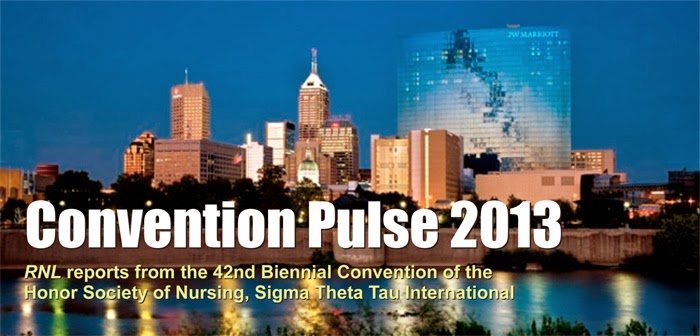Career advice for members
A career in professional nursing often entails a path of twists and turns. For the many who choose the diverse and exciting opportunities that nursing has to offer, the trail may not be straight and nurses don’t always have the tools or know how to navigate their career trajectory.
To meet the career needs of its members, the Honor Society of Nursing, Sigma Theta Tau International, with sponsorship of Johnson & Johnson, offered the Career Management Center (CMC) at the convention. On Saturday, Sunday, and Monday, members came by in great numbers, some with appointments, others as walk-ins, to discuss their career questions and concerns with volunteer career advisors.
 |
| Lois Marshall counsels CMC client. |
Questions ranged from educational advancement and changing career paths in mid-career to how to write a CV, start a consulting business, get started in publishing research findings, and marketing a particular skill set within a specific area of nursing or health care. Some questions could be answered within the space of a brief appointment. Others took up to 30 minutes or more. Advisors spent as much time as was needed with each “client” and everyone left feeling that they had new tools to assist them on their journeys.
The majority of members who came to the center were nurses who were two to five years into their careers, but some had been nurses for more than 40 years. In addition to answering members’ questions, networking between advisors and advisees took place, and, in some cases, possible mentors were either found or recommended, with post-convention follow-up arranged.
Bottom line? The CMC was a great success! Thanks to all who participated.
—Lois S. Marshall, PhD, RN, coordinator, Career Management Center, reporting for Reflections on Nursing Leadership
Attendees ...
Presenters present ...
 |
| Bernadette Mazurek Melnyk, PhD, RN, CPNP/PMHNP, FNAP, FAAN, dean of nursing at The Ohio State University College of Nursing (OSU) and editor of Worldviews on Evidence-Based Nursing, discusses the "so what factor." Read about Melnyk and her efforts to promote wellness at OSU and elsewhere. |
House of Delegates, Session 1 ...
Editor connects with RNL bloggers ...
 |
| Left: Cynthia "Cindy" Clark, PhD, RN, author of "Musing of the great blue," and Jim Mattson, editor, Reflections on Nursing Leadership (RNL) meet in the hotel lobby. Right: Raney Linck, MSN, RN, clinical instructor at the University of Minnesota School of Nursing and soon-to-be RNL blogger, discuss Linck's upcoming blog over coffee at Starbucks. In April, Linck's article, "The mobile revolution is here: What every nurse needs to know," was published in RNL. His blog will also relate to digital trends. Stay tuned. |










_SFW.jpg)
_SFW.jpg)



_SFW.jpg)
_SFW.jpg)
_SFW.jpg)

































